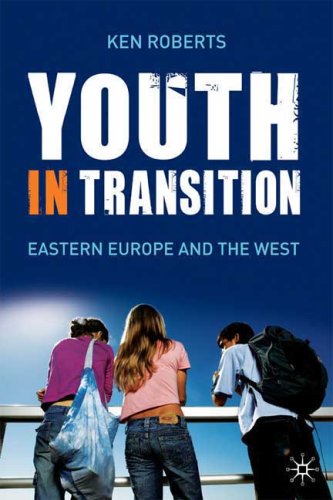Youth in Transition: In Eastern Europe and the West
K, Roberts
Palgrave Macmillan Ltd, Basingstoke
2008
978-0-230-21444-6 (pb)
 Ken Roberts' latest book, Youth in Transition: Eastern Europe and the West, explores the evolution of youth in eastern European countries in the post-communism period. The book compares them to the west over the same period.
This transition is unique to civilization in that these eastern countries were second-world countries (centrally-based economies – politically state controlled) after being annexed in the sphere of the USSR at the end of World War II. Today, it is argued that they are aspiring towards first-world status (capitalist-based economies – free market forces). Most of the countries analysed in this book have recently joined the European Union and this marks a milestone for each of those countries and their citizens.
Ken Roberts' latest book, Youth in Transition: Eastern Europe and the West, explores the evolution of youth in eastern European countries in the post-communism period. The book compares them to the west over the same period.
This transition is unique to civilization in that these eastern countries were second-world countries (centrally-based economies – politically state controlled) after being annexed in the sphere of the USSR at the end of World War II. Today, it is argued that they are aspiring towards first-world status (capitalist-based economies – free market forces). Most of the countries analysed in this book have recently joined the European Union and this marks a milestone for each of those countries and their citizens.
By restricting to the study of youth, there is less analysis of the various influences from the previous era, and their transition gives an insight into the evolution of these countries and which trends are actively changing most. The book looks at several aspects of youth in nine chapters, covering professional aspects such as education and employment, environmental aspects such as politics and housing, through to personal aspects such as family and leisure. For many youth in the eastern block, gradual transition is not enough and they relocate to other countries both within the east and the west. This can happen illegally and so not everyone has benefited from this behaviour. While some have found opportunity in the new cultural changes, many have not and are now dislocated in society with neither income, place of residence, or basic standard of living. The book also recognises that there are general changes which happen as people mature which are unlikely to be influenced by political change.
Roberts suggests that young people in Eastern Europe are in an advantaged position compared to their Western counterparts, because they have experienced a transition which opened opportunities for them to access Western society. Young people from Eastern Europe may become more competitive as they experience life in Western countries, learn foreign languages, and spend more years in higher education than many students in other countries.
However, it is not only the east that has an ongoing transition. The west has also been changing throughout the same period and the book recognises the impact both of the 'baby boom' generation and of globalization. The book also goes further in that comparing studies of youth in the east and the west, it shows not only aspects of their life where they are converging, but also where youth in the east may be already more advanced than those in the west.
The style of the book is very structured and well thought through. It follows an evolution and introduces the issues at the appropriate moment. The language is jargon free and where it is used, the context or definition as it will be used in the book is clearly given. The book draws upon a wealth of recognized mixed method studies conducted both in the east and in the west, and presents many case studies. However, the principles applied in the analysis of the eastern datasets were derived from techniques developed in the west over the past 30 years. For example, chapter four 'Individualisation and the Reflexive Self' applies western theory to Eastern Europe, illustrating the globalization of political, environmental, and many other changes.
Roberts' book can be enjoyed by anyone with an interest in the subject. It is a good resource for anyone studying Youth Studies, Sociology and Cultural Studies. The beginner will find it light enough reading while the experienced professional will find enough substance to discuss or even criticize.
Alena Vasianovich
University of Aberdeen

